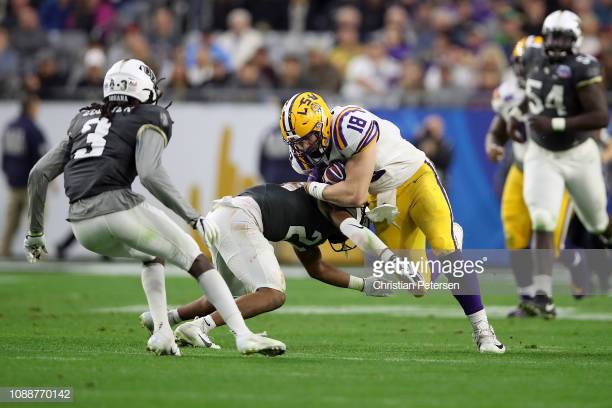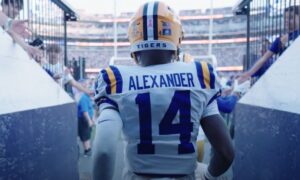From now until the 2019 NFL Draft takes place, we hope to showcase as many prospects as possible and examine both their strengths and weaknesses. Most of these profiles will feature individuals that the Pittsburgh Steelers are likely to have an interest in, while a few others will be top-ranked players. If there is a player you would like us to analyze, let us know in the comments below.
#18 Foster Moreau/TE LSU – 6’4/2, 250 Lbs
The Good
-Experienced blocker in run game and in pass protection
-Has the mindset of an offensive lineman; constantly looks to get a hat on a defender downfield to spring a teammate
-Wide, powerful base in pass protection
-Uses his hands well as an in-line blocker to latch onto target and run him
-Versatile player that lined up all over LSU’s offense the last two seasons
The Bad
-Struggles as a blocker in space when moving to second level; tends to miss his target
-Appears to have heavy feet on film and labors to move in space
-Major contact balance issues; found himself on the ground a lot
-Limited in short area of field due to short-comings as a route runner
-Sluggish in and out of his routes
-Small catch radius and will rarely get to balls outside of his frame
Bio
-Played in 49 career games over four seasons at LSU, starting 32 games, including final 26 games of his career
-Finish LSU career with 52 catches for 629 yards and 6 touchdowns, averaging 12.1 yards per catch
-Finished career ranked No. 7 in LSU history for receptions by a tight end (52) and tied for No. 4 in touchdowns by a tight end (6)
-Invited to 2019 Senior Bowl in Mobile, AL.
-Issued coveted No. 18 jersey at LSU for final season, in which he was named a permanent team captain of the Tigers
Tape Breakdown
LSU senior tight end Foster Moreau is as true of a throwback tight end as we’ve seen in recent years in the NFL Draft process, right up there with Washington’s Will Dissly. Moreau is a block-first, -second, and –third tight end in the 2019 class and serves as an extra offensive lineman when on the field.
That’s not to say he can’t work as a move tight end, because he did at LSU. He just didn’t have the production, or the skill at quarterback, to utilize him and his big frame for the position as a pass catcher.
However, he was one heck of a blocker in the ground game and in pass protection for the Tigers, keeping him on the field for nearly every snap over the last two seasons in the yellow and purple.
On tape, Moreau appears much more comfortable as a blocker in-line, rather than on the move.
When he’s in-line like he is here against Troy in 2017, he’s able to get his hands placed quickly on the defender, and then has the lower body strength to drive his feet and walk the defender off the line.
It’s not the best drive block in the world, but when he’s asked to fire out and pump his feet in the ground game like this when in tight, he’s very effective.
He’s technically sound in his lower half after the snap when getting into position as a blocker too. His feet move much faster as a blocker getting him into position than he’s ever shown in his routes, which is quite confusing. Alas, that’s what happens.
He’s asked to hook the Florida defender here in 2018 on the jet sweep. Watch his left foot at the snap. He takes a wide, angled step, allowing him to get his lower half square with the defender quickly, before then bringing his hands and hooking the defender enough to allow the receiver to sprint by.
Moreau really, really struggles to land blocks when he’s asked to climb to the second level, or move in space as a lead blocker, but he flashed the ability to do it with power and precision against Troy in 2017.
That’s a true pancake block right there.
What you didn’t see in 2018 was him use his upper body strength to finish off blocks like this. He gets too far over his toes quite a bit when on the move and has issues with contact balance and power in space. But again, he’s shown the ability to do it at high level.
As a receiver at LSU, Moreau was limited to the short-to-intermediate areas of the field, largely due to his lack of burst and explosiveness as a route runner. Add in the fact that LSU ran a pro style offense that severely limited the tight end position in the passing game, and, well, it’s easy to understand why he struggled to produce.
One great thing he showed in his abilities as a pass catcher was the feel for finding soft spots in the zone and flashing his numbers there for the quarterback to find him.
This is a simple hitch route against Troy in 2017 that’s designed for Moreau to sit short in hopes of drawing a linebacker and/or a safety to him in coverage, leaving someone else open.
What happens is the linebacker sits underneath his route in zone coverage while the back half of Troy’s defense appears to be in man coverage. Moreau feels the open space to his immediate left and works there, leading to an easy pitch-and-catch for the touchdown.
If you’re going to draft Moreau in this tight ends class relatively early, you’re doing it for his blocking alone, as he can serve as a sixth offensive lineman in many, many ways. But in today’s game, a tight end must add something as a pass catcher or he’s mostly obsolete outside of 12 personnel.
At best, Moreau is a TE2 in a strong offense that can serve as an H-Back of sorts throughout his career. Just don’t expect a major jump in pass catching production at the next level.
Games Watched: Troy (’17), Miami (’18), Georgia (’18), Florida (’18)
Projection: Mid Day 3












